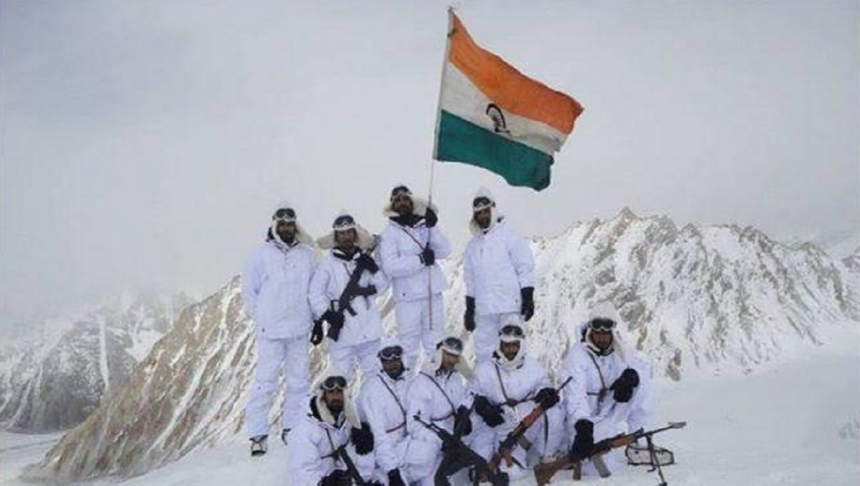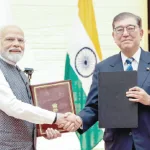Today, the date of 13TH April 2024 being the auspicious day of Baisakhi rings a bell in the ears of all those veterans who forming part of 26 sector under late Brigadier Vijay Chnna as sector commander in Ladakh scripted military victory forty years ago on the anvil of their raw courage and steely determination against an enemy as wily as Pakistan and treacherous as the terrain obtaining as Siachen glacier. Never ever there has been a war that has been fought as long and as viciously as has been at the icy and desolate heights of Soltoro ridge in the annals of human history. Kalidas’s treatise going by the name ‘Meghdoot’ was the chosen one to personify the acts of human endurance by the troops on those glacial heights that seems simply incredulous even to this day.
As ‘Cloud messengers” spearheading one of the longest and still counting operation In the annals of Indian army going by the name ‘OP MEGHDOOT’, there have been countless soldiers and officers who have been relentlessly trudging the same icy heights even today; acting as a bulwark against our western neighbour’s nefarious designs. I too became one of those cloud messengers way back in 1995 when on a crash signal emanating from HQ SFF ordered me to join ‘OP MEGHDOOT’ in Siachen glacier while posted as a company commander at an air maintained forward post in Arunachal Pradesh. Essentially the entire story in this glacial wasteland is that of survival. Survival from the elements of weather and that of evil machinations of our western adversary. In fact this battlefield has been even scripted in one of the best survival Hollywood movies—‘Vertical limit’ that was released about 24 years back staring Chris O’ Donnell, Bill Paxton, Robin Tunney, and Scott Glenn. The movie revolves around a mountaineering expedition to Mt K-2 which is due north of Siachen glacier.
The legacy of Siachen glacier traces its genesis back to the unfinished agenda of demarcation of the CFL (Cease fire line) between India & Pakistan that ended at a place called as NJ9842. It would not be the endeavor of this article to hark back to the days leading to the formation of this Gordian knot that was the combined folly of both the politicians as well as the military commanders of our country who failed to read the insatiable appetite of Pakistan in claiming this triangular wedge of land when time suited their geo-strategic ends. It was only fortuitous that India launched ‘OP MEGHDOOT’ in the wee hours of 13th April 1984 thus thwarting Pakistani designs by a whisker who were literally on the blocs waiting for a favorable weather condition on the glacier. But then fortunes favour the brave. That favorable condition has since proven elusive for Pakistan for the last forty years.
After the Indian long range patrol –Polar Bear II and the Pakistani SSG ( Special service group) came face to face on Bilafond La in the winter of 1983 both sides knew that the other would make a dash for the glacier as soon as the weather permitted. Despite the easier access to the passes from the Pakistani side, India beat Pakistan in the race to Siachen by moving first on 13TH April 1984. And why the name ‘Meghdoot’? Stories about this are part of Siachen folklore in India. Thousands of reams of papers have been rolled out both from the writers and peaceniks across the Radcliff line with many of them coming out with the preposterous idea of turning Siachen Glacier into a ‘Mountain of peace’.Our own ex-PM Man Mohan Singh being one of the biggest votaries of this line of thought. Though the idea of ‘Mountain of peace’ in itself is not abhorred by India on its northern frontiers, it would be well within the realm of country’s think tanks and policy makers to take stock of our western neighbour’s past history in such cases tempered with a sense of realpolitik.
Why is Siachen Glacier so important for India that the country forksout thousands of crores year after year to maintain its one brigade sized (plus) force, where not a single blade of grass grows? Just to recapitulate—The Siachen glacier demarcates Central Asian land mass from the Indian sub-continent as also our two inimical neighboring countries china & Pakistan from joining hands. The so called ‘Triangular wedge’ of Siachen glacier is the only piece of land between NJ 9842 and the Karakorum pass that prevents our two inimical neighbours China & Pakistan from cooking a broth that doesn’t serve our national interests. The 1999 Kargil war was one such broth that was the doing of Pakistan which had its trails leading to the failed attempt to cover itself with glory on the Soltoro ridge in Karakorum mountains way back in 1984.
The area also serves as watch tower for India to keep a watch on Gilgit and Baltisthan regions of Pakistan occupied territory of Jammu and Kashmir. If Pakistan gets a locational advantage by wresting Siachen glacier, it would become a thorn for India from the west in Ladakh in addition to the Chinese threats from the Aksai chin of the east. The 2020 Galwan clash was a reminder for the country that the relentless westward pushes indulged by the PLA was one such aggression that was backed by such a geo-political necessity. Due to its control over Soltoro ridge, India is better placed to strike a bargain while settling bilateral territorial disputes with Pakistan in future. The area also helps India in keeping a hawk’s eye on Chinese activities as Beijing has vastly developed it’s infra in this region. The ‘Trans-Karakorum tract’ or the so called ‘Shaksgam valley abutting Hunza region of erstwhile Jammu and Kashmir which was ceded to China by Pakistan way back in 1963 as a quid pro quo for the former’s efforts in developing the KKH ( Karakorum highway) and many such developmental efforts would further strengthen Sino-Pakistan footprints on these strategic heights.
Perched at an average elevation of 17,000 (seventeen thousand feet) Indian army has even bettered the record of the world’s best armies (read US ARMY deployed in the Alaska region) in safeguarding the country’s territorial sovereignty. It was in December 1983 at a meeting chaired in Pakistan by General Zia-ul-Haq in the GHQ (General headquarters) operations rooms at Rawalpindi to finalize the 10 corps plan prepared by Lt Gen Jahan Dad Khan to occupy Siachen glacier. While the military operations directorate suggested occupation of all key passes by early march, the ‘Force command northern area’ (FCNA) commander Major General Pir Dad khan proposed 1st May 1984 as he felt that the harshness of the terrain, the inability to induct the hepters due to weather conditions and extremely low temperatures would not allow the troops to reach their positions by March 1984. Thereafter preparatory work was started on the procurement of super high altitude equipment and clothing, improvement of roads and tracks, recruitment of porters etc that were supposed to be completed by April 1984.
On the Indian side alarm bells started ringing when intelligence reports trickled in about leave cancellations at FCNA, troop movement towards Khapalu, laying of new communication cables/ exchange / mobile radio stations beyond Skardu and procurement of super high altitude extreme cold weather equipment and clothing from European manufacturers by Pakistan. All this coupled with Pakistani protest notes laying formal claim to the entire region to the west of the imaginary line joining NJ9842 with the Karakorum pass made it evident that Pakistan was planning to take some action across the Soltoro ridge.
The Indian planners reckoned that if the Pakistanis successfully occupied the strategic heights then it would be impossible to dislodge them and they would hence forth dominate the entire region. Therefore to prevent them from altering the status quo to their advantage some kind of pre-emptive action was necessary. The preparations for such an audacious pre-emptive move was set rolling in the right earnest from Jan/Feb 1984 and all plans were tactically evaluated on 26th March 1984 in a two sided war gaming exercise codenamed ‘Walnut-cracker ’ held at the corps headquarters in Srinagar where the crucial decision of heli-dropping of troops to their objective was taken. The entire operation was being closely monitored at the northern command of the Indian army, Udhampur by Lt Gen ML Chibber, army commander, Lt Gen NS Cheema, his chief of staff and Major Gen Amarjit singh, his Major general staff( MGGS). 15 Corps at Srinagar with General officer commanding (GOC) Lt Gen PN Hoon and 3 infantry division at Leh with GOC Major General Shiv sharma were responsible for the overall conduct of the operation on the ground by Brigadier VN Channa, commander 26sector.
Once the final approval on 31st March 1984 given for launch of operation, there was a sense of urgency at all levels of command entailed with this risky mission. Speed of induction, secrecy of the move with need to know based information were the key concepts on which rested the entire success or failure of this operation. The fact that the troops were to be inducted by choppers the ‘Weather God’ was now uppermost in the minds of the planners. While the Indian air force had started their reconnaissance activities in the first week of April 1984 itself, with the stocking of essentials and troop movements at Sasoma and the base camp already underway as per plan, the imported clothing and equipment for the ground troops for which Lt Gen PN Hoon had gone abroad earlier had not yet come. Things did work out positively for the Indian side with the arrival of the much awaited specialized equipment from abroad in time and hence, all heads joined together to find out the most suitable date for this operation.
An act of historical cum mythological serendipity was presented to the planners of this high risk mission with the all-important day of Baisakhi (13th April) just around the corner that symbolized myriad values of valour, happiness, prosperity & harvesting season etc all rolled into one. But the most important facet was the underlying sentiment of valour against tyranny symbolized by this festival as also the formation of ‘Khalsapanth’ on 13th April 1699. Since India wanted to call out the bluff of tyranny of Pakistan in a pre-emptive manner what better date than 13th of April 1984 to kick start this operation when majority of Indians would be busy in the celebrations of this harvesting festival. Cut to the present times with the tally of fatal casualties now numbering more than a thousand in Siachen glacier since the first round was fired across the AGPL40 years ago mainly due to the elements of weather, a lot of work in habitat improvement to include roads, tracks, signal communication etc has made this glacial habitat a bit tolerable.
Military history does provide us many examples when historical cum mythological days formed the backdrop of famous wars and operations. The famous 1973 Yom Kippur war was launched on the ‘Sabbath day’ by Arabs against their bête noire, Israel. ‘Sabbath day’ is considered as one of the holiest days by Jewish fraternity. Though the big guns have fallen silent on both sides of the AGPL (Actual ground position line) since Nov 2003, it would do well for India to keep its powder dry and soundly rebuff the voices of various peaceniks as mentioned above.
(The writer is a retired army officer and can be approached on his email at: [email protected])








